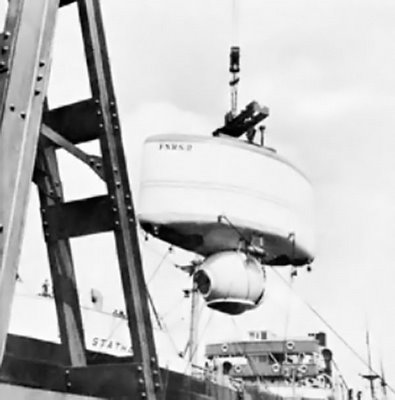|
Piccard`s first version of bathyscaphe, the FNRS-2
 An early type of submersible was a Bathysphere. Bathysphere means deep sphere. In the 1930s, William Beebe and Otis Barton designed a bathysphere and took it to a record depth for the time, 3,028 feet (922 meters). A steel cable and an air-hose attached the bathysphere to a mother ship. The bathysphere only traveled up and down as the steel cable was let in and out. If this cable snapped, the bathysphere would sink to the bottom. Another cable connected to the bathysphere providing power for a telephone and lights. The bathysphere was built for a very specific and functional purpose: its inventor, William Beebe, needed a way to study the inhabitants of the ocean`s deep. An early type of submersible was a Bathysphere. Bathysphere means deep sphere. In the 1930s, William Beebe and Otis Barton designed a bathysphere and took it to a record depth for the time, 3,028 feet (922 meters). A steel cable and an air-hose attached the bathysphere to a mother ship. The bathysphere only traveled up and down as the steel cable was let in and out. If this cable snapped, the bathysphere would sink to the bottom. Another cable connected to the bathysphere providing power for a telephone and lights. The bathysphere was built for a very specific and functional purpose: its inventor, William Beebe, needed a way to study the inhabitants of the ocean`s deep.
Inventor Auguste Piccard improved upon the bathysphere with his design for a Bathyscaphe, which means deep boat. By 1937, he`d designed a small steel gondola to withstand great external pressure; construction began but was interrupted by the outbreak of war. Resuming work in 1945 the steel gondola for personnel was completed and a large float was attached for buoyancy using gasoline as the medium, to make the now floating craft sink tons of iron were attached to the float with a release mechanism. Piccard`s first version of this vessel, the FNRS-2, supported by the Belgian Fonds National de la Recherche Scientifique (FNRS), could dive to 10,000 feet (3,048 meters) without a cable attaching it to a surface ship.
The FNRS-2 made a number of unmanned dives in 1948 before being gifted to the French navy in 1950, where it was redesigned and in 1954 took a man safely down 4,176m (13,700ft).
This was a major improvement over Beebe`s Bathysphere. The Bathyscaphe had two main parts: a cylindrical metal float, from which a steel ball was suspended. The metal float contained gasoline, which provided lift since gasoline is lighter than water. The float also held a couple of tons worth of ballast in the form of iron sheet, scrap iron and gravel. These were held inside the bathyscaphe by doors sealed with electromagnets. If the power failed, the doors would drop open and release the ballast, allowing the bathyscaphe to bob to the surface.
After the FNRS-2, Piccard along with his son Jacques built the Trieste. Begun in 1952, the Trieste was launched on August 1, 1953. The Trieste`s design was similar to FNRS-2.
 |
Palau |
1995 |
FNRS-2 bathyscaphe 13,287 feet |
|